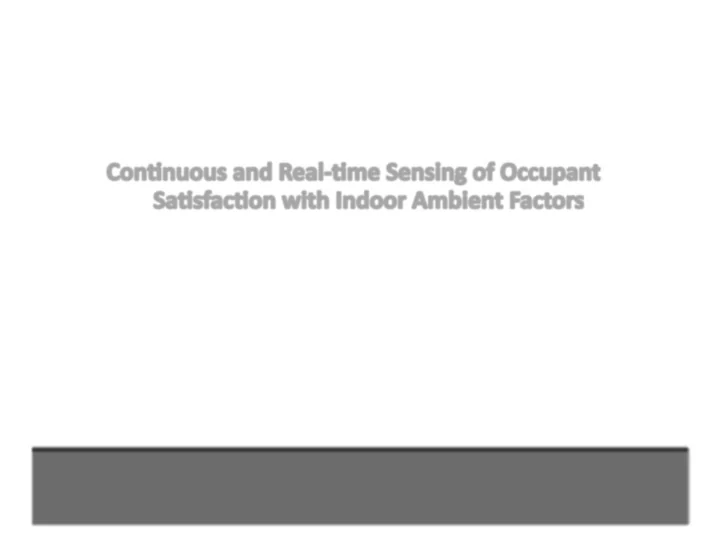

Burcin Becerik-Gerber Assistant Professor Civil and Environmental Engineering University of Southern California becerik@usc.edu http://i-lab.usc.edu 1
Building Energy Consump4on Source: Buildings Data Book, DOE, h?p://buildingsdatabook.eren.doe.gov/ChapterIntro1.aspx 2
Energy Consump4on in the U.S. Residen4al Energy Use Commercial Energy Use Roughly 87% of today’s buildings will s4ll be used in 2050, composing an es4mated 70% of the building stock Source: Energy Data Book (2007); EERE, U.S. Department of Energy 3
Energy Opera4ons 4
Comfort Es4ma4on 5
Energy Efficiency Understand impact of occupant sa4sfac4on with performance, produc4vity, mood BUILDING DESIGN Understand discrepancies between actual measured vs. BUILDING SYSTEM perceived subjec4ve values DESIGN Develop a database of occupant percep4ons for trending BUILDING and improvements to energy opera4ons (hea4ng/cooling, OPERATIONS ven4la4on, building design) BUILDING Develop op4miza4on algorithms for “learning” and PERFORMANCE “adap4ve” energy control 6
Par4cipatory Data Sensing Mobile triangula4on brings up a list of three nearest buildings 7
Par4cipatory Sensing Occupant Supplementary Data for Occupant Preferences Energy Analysis Profile 8
Mobile Apps 9
Mobile Apps 10
Comfort Es4ma4on Ten days ‐ eight rooms ~ 65% of occupant percep4ons of temperature differed from the neutral condi4on Could be due to the malfunc4oning sensors or mismatch between comfort ranges /set points Jazizadeh F, Kavulya G, Klein L, Becerik‐Gerber B. (2011) “Con4nuous Sensing of Occupant Sa4sfac4on with Indoor Ambient Factors”, ASCE Workshop of Compu0ng in Civil Engineering, June 19‐22, 2011, Miami, FL 11
Building Level Energy Management System 50 permanent residents (staff/ faculty/grad students) and more than 2000 temporary residents 64‐wired sensors 500+ WiFi‐based wireless sensors (temperature, humidity, light, CO2, sound, magne4c, and mo4on sensors) deployed in 60 moveable sensor boxes and 100+ actuators 10 sub‐meters (sub‐floor, floor and building level for measuring energy consump4on of ligh4ng, receptacles, HVAC, elevator, and emergency power) 12
Energy Literacy Building Visualiza4on Energy Management Input Energy Awareness Personal energy choices vs. global well‐ Public Awareness being? Broad Cultural Ship About Energy – Social Influence 13
Data Visualiza4on Cold 14
Data Visualiza4on Cold Cool Neutral Warm Hot 15
Energy Networking User Forum 16
Energy Networking User Forum 17
Energy Networking User Forum 18
Occupant Feedback • Focus on the contribu4on of building occupants in energy reduc4on • Occupants are asked to reduce ligh4ng level during the day without compromising visual comfort • Assess the influence informa4on on occupants’ behavior towards energy conserva4on: – Reminding to reduce ligh4ng w/o any suppor4ng informa4on – Energy consump4on w/Environmental informa4on are Changes in occupants behavior provided to encourage ligh4ng level adjustment towards energy conserva4on is – Peers/colleagues ‘ tendency to reduce ligh4ng level is monitored by wireless light revealed to all occupants to use social influence for sensors which are used to energy consump4on reduc4on measure the electricity consump4on indirectly 19
Occupant Feedback • Areal‐world test scenario; a pilot sample of par4cipants (staff on campus) • To inves4gate the impact of different types of informa4on for changing occupant behavior Test Group I: no addi4onal informa4on, simply ask to reduce the level of ligh4ng Test Group II: informa4on including par4cipant’s own energy use, rate, and environmental mo4ves “ By reducing (dimming) the ligh0ng level in your office, you can reduce the total building energy consump0on. If you agree, the annual energy savings at the building level are 26000 kWh on average, which is equivalent to the reduc0on of CO2 emissions of 2.2 homes for one year and greenhouse gas emissions avoided by recycling 6.2 tons of waste.” Jazizadeh F, Kavulya G, Kwak J, Becerik‐Gerber B, ( 2012 ) “Human‐Building Interac4on for Energy Conserva4on in Office Buildings”, CRC 2012: Construc0on Research Congress , May 21‐23, 2011, West Lafaye?e, IN 20
Occupant Feedback 21
Energy Conserva4on 22
Students & Collaborators & Sponsors Farrokh Jazizadeh Geoffrey Kavulya Nan Li Zheng Yang Award number: DE‐EE0004019 23
Thank you! 24
Recommend
More recommend